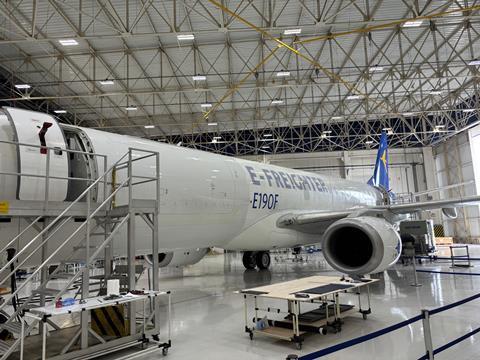Embraer is hoping to tap into continued e-commerce growth to provide lift for its fledgling E-Jet passenger-to-freighter conversion programme.
Marcelo Tocci is Embraer’s director for the E-Jet conversion programme. Speaking to FlightGlobal at the airframer’s Sao Jose dos Campos headquarters in Brazil, he says E-Jet converted freighters are “a perfect fit” for e-commerce, especially to serve smaller communities.

“I think [e-commerce companies] are realising there are a lot of smaller cities throughout their countries or even in the region that have not been served. And I think we are the perfect fit,” says Tocci.
Launched in 2022, the E-Jet passenger-to-freighter programme covers the conversion of both the E190 and E195. The first E190F took off on its maiden test flight on 5 April, and its second sortie was conducted five days later.
The E190F will have a payload of 10,700kg (23,600lb), while the E195F’s will be 12,300kg.
Certification from Brazilian, US and European regulators is targeted for the second quarter of the year, with service entry to follow.
The airframer forecasts a global market for about 600 small freighters over the next 20 years. Of these, about a third will go to the Asia-Pacific, underscoring the “immense opportunity” in the region, says Tocci.
He adds that Embraer is “looking carefully into” opportunities in Southeast Asia, noting the growth in economies in countries like Vietnam.
It has a sole Asian customer for its freighter programme: Lanzhou Aviation Industry Development Group in China, which signed for 20 E-Jet freighters at the 2023 Paris air show.
Raul Villaron – who heads up Embraer’s commercial aviation business in Asia Pacific – agrees that the “new dynamics” in e-commerce are an area of opportunity for the freighter programme in Asia.
“If you have larger aircraft going only to big hubs, it will take a longer time. E-commerce needs faster deliveries… to smaller cities,” he adds.
Villaron also notes that Australia offers “plenty of opportunities”, given the presence of ageing freighters like the British Aerospace BAe 146. For instance, Pionair Australia is an operator of the type, according to Cirium fleets data.
Arjan Meijer, chief executive of Embraer Commercial Aviation, adds: “The [existing] aircraft flying this segment are really old. If you look at the profile [of freighters] across the different profiles, there is a dip in [the small narrowbody freighter] segment, not because there is no demand, but because there’s nothing available.”
Tocci also notes that about two-thirds of the projected small freighter deliveries will be for growth purposes, with the remainder for replacement.
Like Meijer and Villaron, he believes there is scope for the E-Jet freighters to replace older and larger narrowbodies.
The airframer is also looking at pitching the type at turboprop freighter operators. Adds Tocci: “We believe there is way more productivity in having a jet [like the E-Jet] replace a turboprop – there is more range… and we are also talking about cost efficiency. When you get beyond the 700nm [1,300km] range for cargo operations, you will find something like the E-Jet more efficient.”

Conversions take place at Embraer’s Sao Jose dos Campos facility, with two lines currently operational. It is standing up two more lines, with a goal to convert up to 12 freighters per year.
As part of the deal with Lanzhou Aviation, Embraer could also establish a conversion facility in China.
Tocci suggests that Embraer is open to various options for the modification work in Asia, including Embraer performing conversions in-house, using a third party, or forming a joint venture.


























